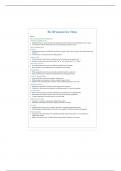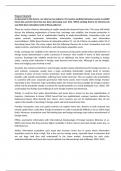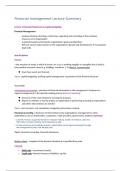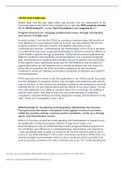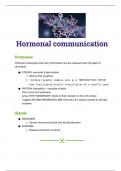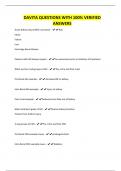Theme 1
Rules for organising information alphabetically
1. Introduction to Alphabetic Filing:
• Alphabetic filing is a systematic method of organizing information based on the alphabetical order of names.
• It is essential for efficient information retrieval and maintaining organized records.
2. Rules for Alphabetic Filing:
a. Name Units:
• Organizational names are divided into units based on specific criteria, such as prefixes, titles, abbreviations, and
acronyms.
• Treat each unit as a separate entity for filing purposes.
b. Prefixes and Titles:
• Prefixes and titles within names are considered part of the name, not as separate units.
• Examples include personal name prefixes like "de" or "von" and titles like "Dr." or "Capt."
c. Abbreviations and Acronyms:
• Treat abbreviations and acronyms as single units, ignoring any punctuation.
• Ensure consistency in how abbreviations are treated for accurate filing.
d. Geographic Names:
• Divide geographic names into separate units, considering hyphens as single units.
• Special consideration for prefixes and hyphenated parts of geographic names.
e. Numbers in Organizational Names:
• Arabic and Roman numerals are treated as separate units.
• Ordinal numbers are treated as if written in standard numerical form.
• Sequence units containing numbers in numeric order, considering both figures and words.
f. Alphabetizing by Addresses:
• Alphabetize organizations with similar names based on their addresses.
• Consider city, state, street name, direction, and building numbers for accurate sequencing.
g. Government Names:
• Federal, state, and local government organizations have specific rules for alphabetization.
• United States Government is treated as the first three units for federal organizations.
• Transpose department and office names for accurate filing.
3. Importance of Consistency:
• Consistency is crucial for maintaining an efficient filing system.
• Adhering to standardized rules ensures uniformity and ease of retrieval.
4. Conclusion:
• Alphabetic filing rules provide a systematic approach to organizing organizational names.
• Understanding and applying these rules correctly are essential for effective information management.
5. Practical Application:
• Apply these rules systematically when organizing and filing organizational names in any professional or
administrative setting.
• Regular training and review of filing procedures help maintain consistency and accuracy.
, The Discipline of Organizing
Chapter 1: Foundations for Organizing Systems
1.1 What is an Organizing System?
• Definition: An Organizing System refers to any system that arranges resources intentionally to achieve specific purposes.
• Characteristics: Involves intentional arrangement by individuals or institutions; may emerge from collective behavior; can be
self-organizing; examples include libraries, museums, businesses, ecosystems, and digital platforms like Wikipedia and
Flickr.
1.2 The Concept of "Collection"
• Definition: A collection refers to the set of resources organized within an Organizing System.
• Characteristics: Collections can be physical or digital; may encompass various types of resources such as books,
documents, data, or digital media.
1.3 The Concept of "Intentional Arrangement"
• Definition: Intentional arrangement emphasizes the deliberate organization of resources by individuals or
institutions.
• Characteristics: Can be top-down (centralized authority) or bottom-up (emergent from collective behavior);
examples include libraries, museums, and digital platforms.
1.4 The Concept of "Organizing Principle"
• Definition: Organizing principles are directives guiding the design or arrangement of resources within an
Organizing System.
• Characteristics: Influence the organization of resources based on properties such as name, category, or frequency
of use; may be general or specific; examples include alphabetical or chronological ordering.
1.5 The Concept of "Agent"
• Definition: An agent refers to any entity capable of autonomous and intentional organizing effort within an
Organizing System.
• Characteristics: Agents can be human or computational; may perform organizing tasks autonomously or collectively.
1.6 The Concept of "Interactions"
• Definition: Interactions encompass actions, functions, services, or capabilities that make use of resources within an
Organizing System.
• Characteristics: Fundamental for accessing and utilizing resources; may vary based on resource characteristics and
system design; examples include searching, browsing, and annotating.
1.7 The Concept of "Interaction Resource"
• Definition: Interaction resources are traces or evidence left by interactions with resources within an Organizing
System.
• Characteristics: Can be intentional or unintentional; may include digital records, usage data, or sensory information;
used to analyze user behavior and optimize system performance.
1.8 Organizing This Book
• Overview: The book aims to explore the design and deployment of Organizing Systems, emphasizing the
interconnectedness of information organization and retrieval.
• Structure: Chapters cover design decisions, activities, and resources within Organizing Systems, providing a
comprehensive understanding of their functioning and significance.
Conclusion:
• Summary: The study notes provide a foundational understanding of Organizing Systems, including their definitions,
concepts, and key characteristics.
• Importance: Understanding Organizing Systems is essential for various domains, from libraries and museums to
digital platforms and business operations.
• Future Directions: Further exploration of Organizing Systems can lead to advancements in system design,
information management, and user experience optimization.
,Chapter 2: Design Decisions in Organizing Systems
Introduction to Dimensional Perspective:
• The dimensional perspective facilitates cross-disciplinary discussions on organizing activities.
• It allows translation between category-specific vocabularies, aiding mutual understanding.
Understanding What is Being Organized:
• Resources can be treated as unique items, members of categories, or components based on context.
• Digital resources offer scalability and efficiency compared to physical ones, as they can exist in multiple locations
simultaneously.
Purpose of Organizing:
• Libraries, museums, and archives prioritize resource preservation, classified as memory institutions.
• Businesses and governmental agencies organize information for compliance, transparency, and business continuity.
Value Allocation and Decision-Making:
• Resource organization aims to allocate value for certain stakeholders, influencing decision-making.
• Subtle differences in organization, such as arrangement and framing, can significantly impact decisions.
Extent of Organization:
• Different organizations may vary in the extent or granularity of resource description based on business strategies
and target customers.
• Detailed descriptions produced by technology may seem authoritative but can raise privacy concerns.
Timing of Organization:
Organization can occur "on the way in" during creation or "on the way out" during interaction with resources.
Roles in Organization:
• Professional indexers and catalogers undergo training to maintain high-quality organizing systems.
• Authors provide subjective descriptions, while users contribute to emergent organization in informal contexts.
Location in Organization:
• Location plays a crucial role in organization, often tied to jurisdictional regulations and user needs.
• Digital resources are stored in the cloud, with location often being invisible and irrelevant.
Integration of Design Dimensions:
• Organizational decisions are interconnected, and the consideration of one dimension often impacts others.
• The architectural design of organizing systems should accommodate adaptability and evolution.
Conclusion:
Understanding the various design dimensions is essential for creating effective organizing systems that meet diverse
needs and adapt to changing contexts.
Chapter 3: Activities in Organizing Systems
1. Introduction to Organizing Systems:
• Organizing systems involve various activities such as selection, organizing, interaction design, and maintenance.
• These activities differ across domains but share common principles facilitating communication and learning.
2. Selecting Resources:
• Organizing systems are built around specific resource domains.
• Memory institutions select rare items, whereas scientific research often requires representative samples.
• Selection criteria can be unconventional and influenced by factors such as creators, processes, and biases.
3. Organizing Resources:
• Properties of resources guide their organization.
• Principles like Gestalt psychology inform how we perceive and organize visual stimuli.
• Built environments can be designed to shape interactions and perceptions.
• Information architecture involves designing effective information organization for navigation.
, 4. Organizing with Descriptive Statistics:
• The level of measurement (nominal, ordinal, interval, or ratio) determines the appropriate quantitative organization
of data.
• Statistical descriptions summarize resources and enable comparison within the collection.
5. Organizing with Multiple Resource Properties:
• Multiple properties of resources, users, and environments collectively influence organization.
• Trade-offs exist between the effort invested in organizing resources and the ease of finding and using them.
6. Affordance and Capability:
• Affordances describe the inherent properties of resources that enable interactions.
• Designs should consider users' capabilities to ensure accessibility and effectiveness.
7. Value Creation with Digital Resources:
• Digital resources enable information exchange and symbolic manipulation.
• Interaction with digital resources involves navigation, search, and manipulation of data.
8. Preservation:
• Preservation aims to protect resources from physical damage or deterioration.
• Digitization is not preservation alone but can aid in long-term access to resources.
9. Curation and Governance:
• Curation involves maintaining resources over time to ensure accuracy, completeness, and accessibility.
• Governance focuses on policy-making and management within organizing systems, including data retention and
privacy.
10. Computational Curation:
Algorithms and tools aid in data cleaning, relevance improvement, and predictive maintenance.
11. Discarding, Removing, and Not Keeping:
• Maintenance involves phasing out obsolete or irrelevant resources to make room for new ones.
• Various domains have mechanisms for discarding resources, such as de-accessioning in memory institutions and
retiring legacy software versions.
12. The Long Tail of Dark Data:
• Scientists often hold unpublished "dark data" due to limited interest or negative findings.
• Accessibility to such data could improve with platforms akin to Netflix for Science.
Key Points Summary:
• Organizing systems encompass selection, organization, interaction design, and maintenance activities.
• Selection criteria vary across domains, influenced by rarity, representativeness, and biases.
• Properties of resources, users, and environments shape organization and interaction.
• Affordances and capabilities guide resource interaction and accessibility.
• Preservation, curation, and governance ensure resource integrity and accessibility over time.
• Computational tools aid in data cleaning, relevance improvement, and predictive maintenance.
• Discarding obsolete resources is essential for maintaining relevance and efficiency.

